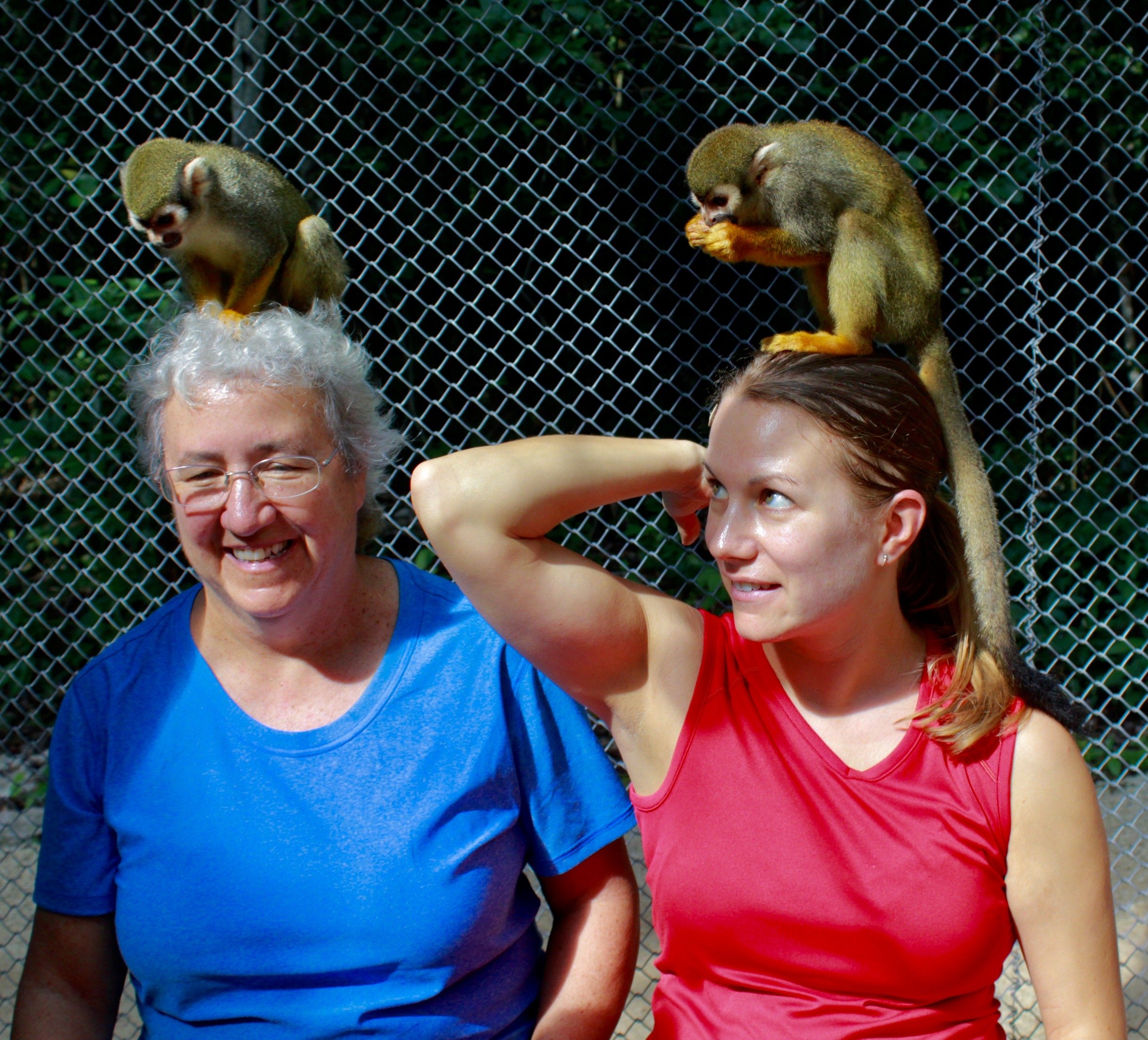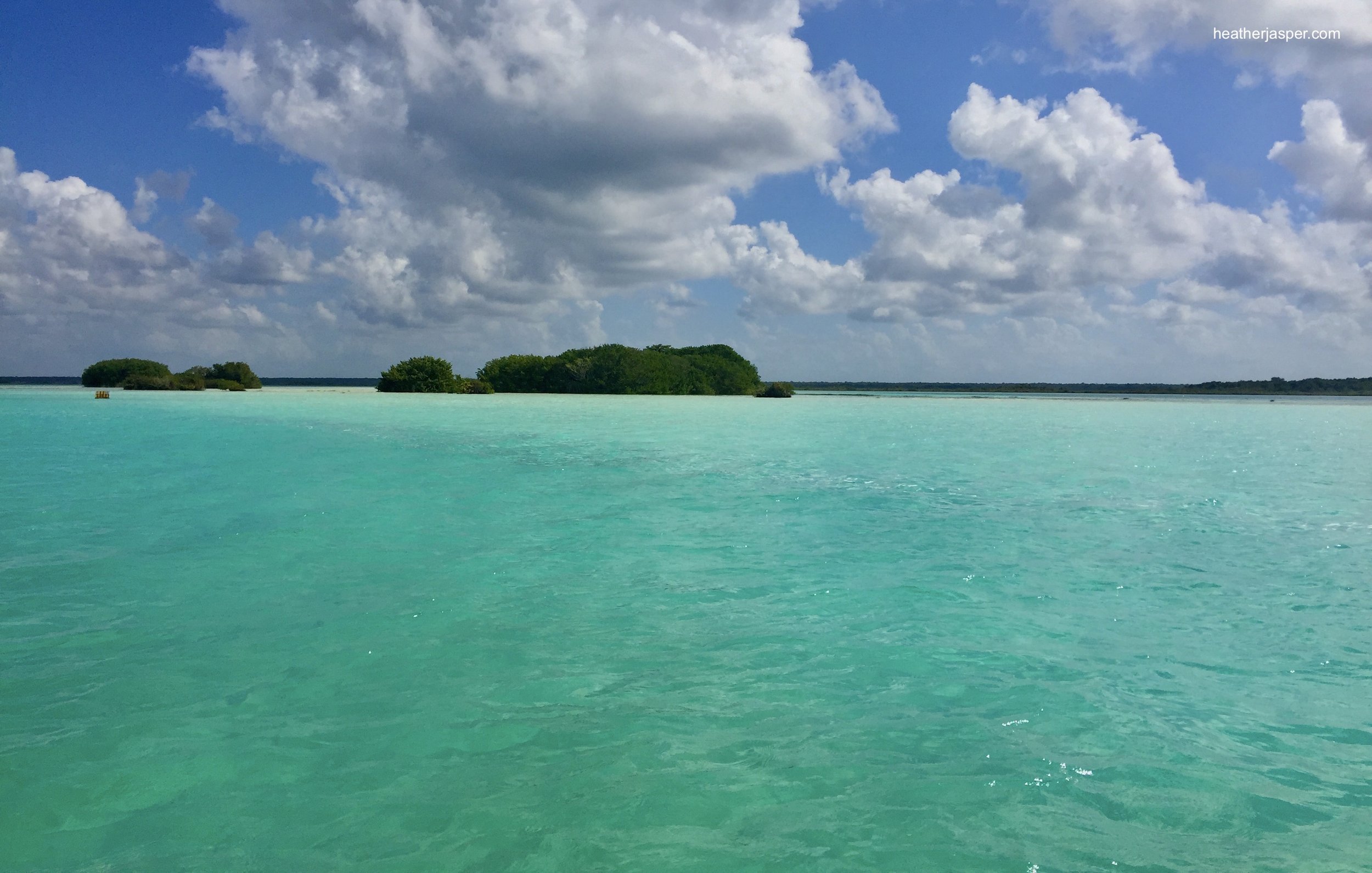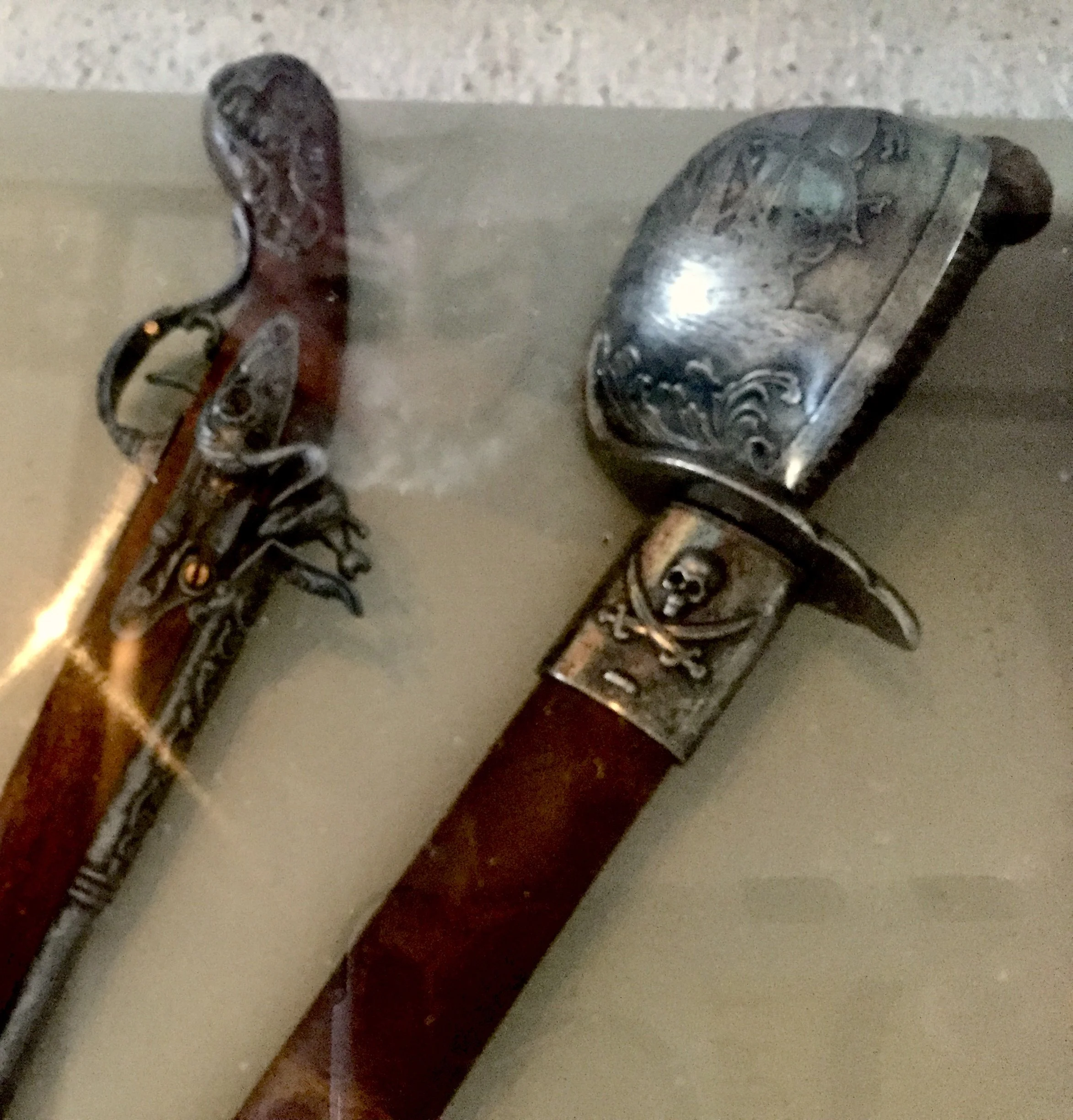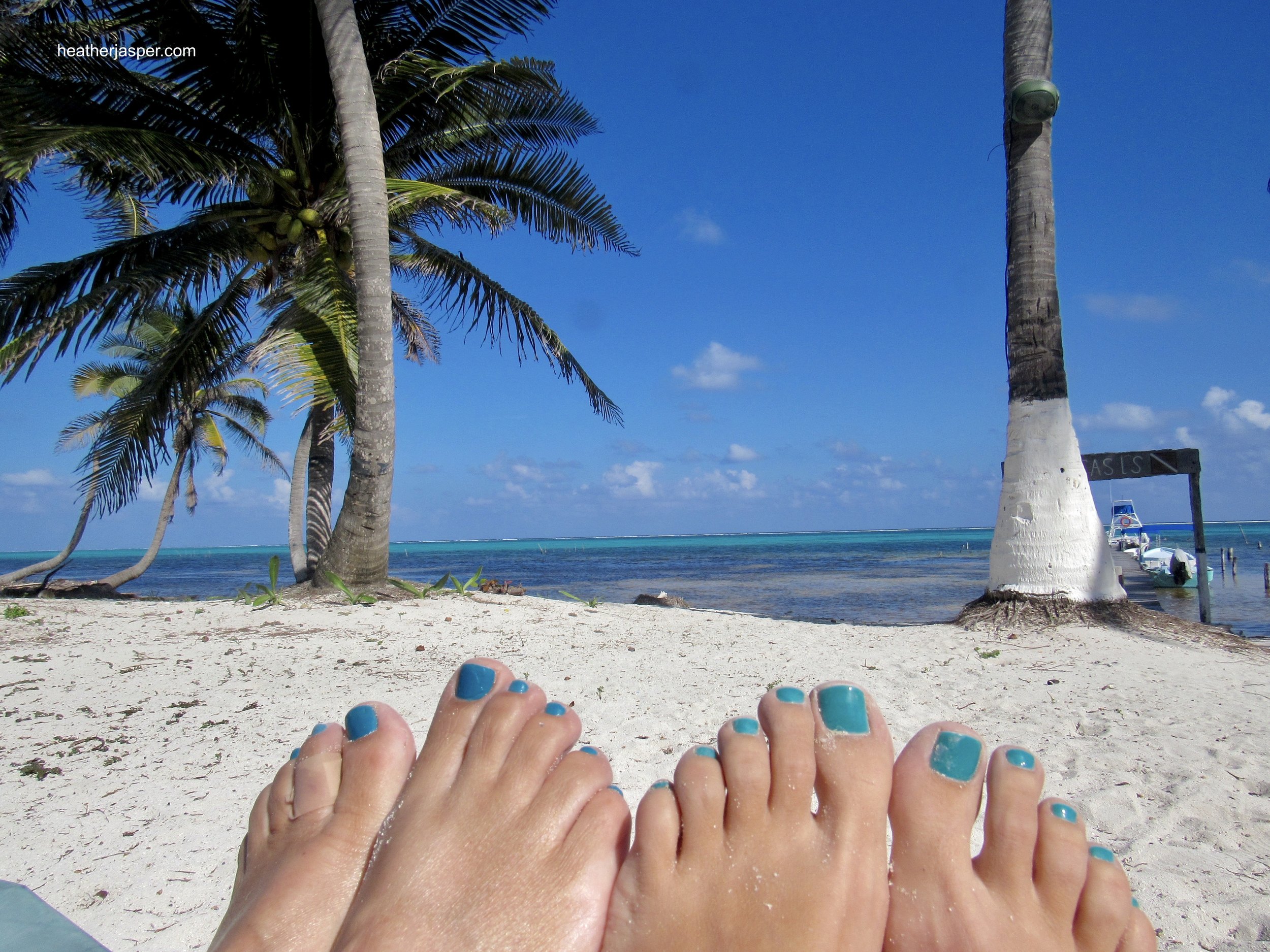Quintana Roo by Road
Mexico’s Quintana Roo state and the Yucatán Peninsula are the perfect place for a road trip.
One of my few trips that wasn’t solo travel, this first ever travel adventure with my mother was beautiful from start to finish. We landed in Cancún and drove down to Puerto Aventuras for two nights, then farther south to Mahahual for five nights, then north to Tulum for two nights with our final night in Puerto Morelos. It’s hard to fit all the adventures of such a packed trip into one blog, but here are the highlights.
For a succinct list of 10 great travel tips for this same area, check out Travel Canyon’s Yucatan blog.
Playa del Carmen was just as commercial as we expected.
Driving our rental car down from Cancún, we only stopped long enough for lunch, and to see what kind of a place Playa del Carmen has become. My parents traveled the area in 1976 and the Isla Mujeres they visited didn’t have hotels or even real restaurants. They had to buy a hammock to sleep in and ate at taco stands. Back then, they laughed at the idea of the Mexican government making a city called “Cancún” with an international airport, when it was clearly just deserted jungle, far off the beaten path. Of course, everything is very different now and Playa del Carmen has grown right along with Cancún. We walked the main street, marveling at the giant shops of souvenirs, brand name clothes and fine jewelry. The real jewel we found was the Frida Kahlo Museum. The entry price includes a guide, who actually added a lot to the visit. It’s very well done and even though I thought I knew a lot about Frida, I still learned quite a bit about her and her paintings. I highly recommend it, if you ever find yourself in Playa del Carmen.
Puerto Aventuras is a comfortable and quiet gated community.
We stayed in a very nice condo back in the jungle but within an easy walk to the beach and all the big hotels there. Most of the beach is full of palapas and chairs that belong to the hotels, but we found enough beach space to ourselves in the morning and plenty to do. This beach had the best shells and washed up coral bits of all the beaches we saw, and the fish were not shy. I think we were seeing mostly butterfly fish, which swam right around our legs if we stood still. It was also the only place we saw wild monkeys, hooded oriels and agouti (agutí in Spanish). All three were in the jungle near our condo. We spent one afternoon at Cenote Azul which was cool and refreshing while the beach had become unbearably hot. The fish were beautiful and there were iguanas in the trees and birds all around. It truly was like an oasis, with orchids and unbelievably clear water. As afternoon moved towards evening the birds came out, especially the bright yellow Social Flycatcher (X’takay in Mayan).
The Akumal Monkey Sanctuary as so much more than monkeys.
Leaving Puerto Aventuras, we stopped in Akumal to see the Monkey Sanctuary. We had a fantastic guide named Alex, who told us all about the animals there and how they each came to be rescued. The place has only been open for a few years and they receive donations constantly. It’s legal in Mexico to own a few species of monkey as pets and although some people are good owners, monkeys are not an easy pet and many get abused or abandoned. If you see anybody on the beach with a monkey on a leash and a collar around its neck, don’t give them money for pictures. Collars are painful for a monkey and although a harness around their body would be less cruel, they really should be in the wild or at least in an enclosure with a tree to climb on, not put on strangers’ shoulders for money. Hence the need for a sanctuary.
Squirrel Monkeys
It seems hokey, but squirrel monkeys have to eat sometime and it might as well be while sitting on your head. I would only do this at a place I am convinced is a true animal sanctuary that is working to rehabilitate and release animals.
The Akumal Monkey Sanctuary takes in just about any animal in need, so there are ostriches, giant boas and pythons, peccaries and everything from parrots to zebras. Recently they accepted a container of pygmy goats, only to find that it also had a kangaroo and deer inside. Since they’re not at all set up to house a kangaroo they had to find it another home, but kept the goats and European deer. Or course, the animals that are not native to the Yucatan peninsula cannot be released, but they do rehabilitate as many native species as possible for release to the wild.
Mahahual is far but absolutely worth the drive.
This was the place we stayed the longest and it was fantastic for day trips to several nearby destinations. It’s a long drive from just about anywhere and when you make it to town you are greeted with the sign “Por fin llegaste. ¡Bienvenido!” (Finally you arrived. Welcome!). We stayed in the home of the town’s yoga teacher, in the part of town that is near the cruise ship port, not right on the beach. Since we had a car it only took a few minutes to get out on the highway and over to the beach part of town.
Every day cruise ships dock in the morning and innumerable souvenir shops and tables with conch shells would pop up along the malecón, only to disappear in the evening when everybody went back to the ship. It was very lively during the day and we enjoyed the people watching and the painted benches along the malecón. Some were just murals, but several were clearly books, the sides of the benches painted as pages and a cover. We identified The Little Prince and Peter Pan easily, although some books were more obscure.
Evenings were calm and although the beach was dark, the restaurants along the malecón were all open. Our favorite was Fernando’s for the little smoothie and tequila shot served before you order, the array of salsas served with chips, the excellent and very cheap meals, and the shot of coffee and tequila served after the meal. We also tried a few other places, which were all excellent. We went on a snorkel with Doctor Dive and had an outstanding guide, (an Italian named Nico), who was very good at pointing out all the different fish and animals, then surfacing to tell us their names. We saw several sea turtles, sting rays, a yellow spotted moray eel, lobster and more fish than I could possibly name. The coral looked a little tired and in some places showed a lot of damage, but there was still a good amount of wildlife to see.
I loved Bacalar’s lagoon and was surprised by the pirate history.
An easy day trip (one hour driving) from Mahahual, the Bacalar Lagoon is spectacular. The name Bacalar means “seven colors” in Maya, which is a perfect description of this body of fresh water. Like the whole peninsula, the bottom of the lake is white limestone and where the water is shallow it is the palest shade of turquoise, fading to deeper shades of turquoise, green and blue where the lagoon is deeper. There are several cenotes in the lagoon and at the edge of each the color abruptly changes from light turquoise to the darkest navy blue.
I had always thought of cenotes as places surrounded by jungle, holes through the limestone cap into the freshwater aquifer that is so close to the surface all over the peninsula. The cenotes in Bacalar are in the lagoon, but still qualify as cenotes because they are holes in the limestone crust, clearly visible as deep water and the source of the freshwater of the lagoon, that pours out strong enough that the places where the lagoon joins the ocean never take in saltwater. The entire lagoon is pure and incredibly clear freshwater. It’s also the largest such body of water in Mexico: 42 kilometers at its longest part.
Besides a tour of the lagoon by boat, the other must-do in town is the fort: Fuerte de San Felipe. It was built by the Spanish but taken by the Maya and held as their base from which to attack the Spanish from 1850 to 1901. Inside the fort is a museum with an astounding amount of information about the Mayan civilization in the area before Europeans arrived, the colonial period and the complicated history of the pirates, privateers and buccaneers who attacked or used the lagoon during the period that pirates actually controlled much of the Caribbean. I found the detailed history of the Irish pirate Anne Bonny and the English pirate Mary Read to be fascinating.
Pirate History
Besides the thorough panels about the history of the fort, there is also an impressive array of artifacts: everything from ceramic Mayan art found in cenotes to pirate swords and a pirate skeleton.
Bacalar Toes at Xcalek
We were so impressed with the colors of Bacalar’s lagoon that we got pedicures of our favorite lagoon shades.
Xcalek had the best snorkeling plus manatees in the mangroves.
Pronounced “eesh-ka-lek”, this little village is the end of the road, as far as you can drive down the coast towards Belize. The only thing to do in town is snorkeling and diving, so we went with the recommended XTC Dive Center and signed up for a snorkel that included a tour of the mangroves and search for the elusive manatee. The only other tourists were a couple from Germany and they joined us on the tour. The mangroves were interesting and we did spot a manatee briefly in a channel that is the border between Mexico and Belize: the mangroves on the north side belonging to Mexico and the ones on the south side of the channel belonging to Belize. During our three hour tour we saw only one other boat, a fisherman from Belize who sped through while we were quietly waiting for the manatee to surface again.
During our snorkel we saw much healthier coral than in Mahahual and lots of eagle rays. Much bigger than sting rays, they were square and dark gray, almost black with white spots. We snorkeled at two different spots on our way back to Xcalek from the border area, both teeming with more wildlife than we saw in Mahahual.
Dos Ojos was our favorite cenote and had great evening bird watching.
We stopped at Cenote Dos Ojos on our way from Mahahual to Tulum, although we had to go a bit past Tulum to get there. The two “eyes” that make it are quite different, with the first eye being much smaller and more of a half circle, like an eye winking. We stayed until the worst of the crowd had left in the afternoon and were rewarded with a turquoise-browed Motmot, the bird I had first seen at the Monkey Sanctuary near their little cenote. It stayed close enough I was able to take dozens of photos before it flew off. “El Segundo Ojo” was much bigger and clearly a circular piece of the limestone crust that had fallen in, exposing a ring of perfectly clear water.
Even though the sun was low in the sky, it was still light enough to see the intricate rock formations below me as I swam, hearing bats squeaking to each other as they woke up. I swam until the place closed, having it to myself for well over twenty minutes at the end. Below the white floor glowed, showing off the remnants of stalagmites from when the last ice age drained the water from the Yucatan, creating caves with both stalactites and stalagmites. The ice age long gone, most of these cenotes’ formations are now underwater.
Tulum is overrated but if you get up early the ruins are nice.
We spent two nights in Tulum and that was plenty. It’s a well known place and I can only assume that the town has a very skilled chamber of commerce and robust marketing campaign. The town is full of tourists, although we didn’t see anything worth doing in town besides shopping and restaurants. It’s not a very interesting place. The ruins are apparently the big draw and we followed the advice to get up early and try to be at the ruins when they open. (You can buy tickets in advance here). We didn’t have to wait in line and most of our photos don’t have other people in them, but that quickly changed.
After about an hour, hordes of tourists, most of them in a group with a guide, swarmed every path, making it difficult to even walk around, let alone enjoy the ruins. We fled, thankful that we had managed to see everything before the place was overrun. On the way out, we stopped at the gift shop for a book and some postcards. Next to the gift shop, outside the turnstile where you have to show your ticket, is an interesting little room with information about the restoration work that has been going on for the past several years. It has great information on the murals painted on and in the ruins, with many photographs and recreations of what the paintings had originally looked like. There were only a couple other people in there and the room didn’t seem to be visited much.
Back outside, we walked towards the booth where we had bought our tickets and were astounded at the hundreds of people standing in the sun, waiting in line to buy tickets. Every path of the ruins was already overcrowded. I couldn’t imagine how all those people standing in line were going to find space to walk once they got inside. Walking the quarter mile back to the parking lot we were swimming against a tide of hundreds more people, heading to the line to buy tickets that was already impossibly long. If you ever want to see the ruins at Tulum, get there right when they open and don’t plan to stay more than an hour or two, unless you like waiting in line and standing in giant crowds.
Puerto Morelos was a surprise bonus and much nicer than we expected.
This is an adorable little town and by far the best beach we saw on our trip. It didn’t have giant hotels claiming every inch with their lounge chairs and palapas. Right in town is a park that goes up to the beach, so that whole stretch of sand is open to all. All of the beaches we saw on the trip are public, although access is so restricted by big hotels in places like Tulum that you can hardly get to the beach. Puerto Morelos was a refreshing change. There was plenty of space for the beach chairs we borrowed from our guest house (http://laylaguesthouse.com Highly recommended).
I went on a snorkel while Mom relaxed on the beach and was very impressed by the health of the reef. Unlike the other places we’d snorkeled, we were required to wear life jackets, which I thought was very annoying at first. I was used to diving down to see things up close. However, once we got in the water I understood. The water was so shallow that you couldn’t possibly get any closer by diving down. In many places, the coral was only an inch from the surface, making more of a maze to find your way through than a sea floor that you had to dive down to see, like in Xcalek.
The town lobbied years ago for the government to declare the area a protected reserve and they have done a fantastic job of keeping the coral healthy. At other beaches, I would dive down to try to get closer to parrotfish, only to have them hide in the coral. The parrotfish in Puerto Morelos were not as shy and it was easy to see them up close, since the coral was so close to the surface. We all did our best to keep our arms and legs on the surface, never lowering our fins near the coral, but a few times it was so shallow that I was glad for the lifejacket, fearing that the coral would scrape my stomach. I don’t think I ever touched any, but I had to be very careful since it was so shallow.
We snorkeled two different spots, the second one farther out, but both relatively close to the beach and both with amazing coral and wildlife. I spotted the largest lobster I’ve ever seen, partially hidden under some coral, pinchers out in case I got too close. I swam next to a large eagle ray for several minutes without it seeming bothered by how close I was. I saw schools of bright blue and yellow grunts, larger than the schools of blue tangs that Mom and I saw in Xcalek and more Caribbean fish than I can name here. There were several sting rays too, but I never saw the promised nurse sharks.
Back on the dock, I watched fishermen gutting huge grouper and throwing the guts to the pelicans swarming around their boat. I was surprised to see two giant white rays circling the dock, perhaps waiting for some of the pelicans to drop the fish guts. Tourists on the dock were pointing to them and calling them sting rays, although I had seen several sting rays while snorkeling and they were a yellowish tan, and never larger than a foot or two across. These rays were easily ten to fifteen feet wide, perhaps larger since the water distorts size, and very light gray or white. I don’t think they could have possibly been anything besides manta ray, which do live in the area. Overall, I was very impressed with the coral and wildlife just off the beach in Puerto Morelos. The town itself has the feel of a real community with a bookstore (the first we’d seen on the trip) and central square right on the beach, where kids roller skated and played soccer late into the evening. It was a beautiful end to our trip, and definitely a town I’d go back to.






















